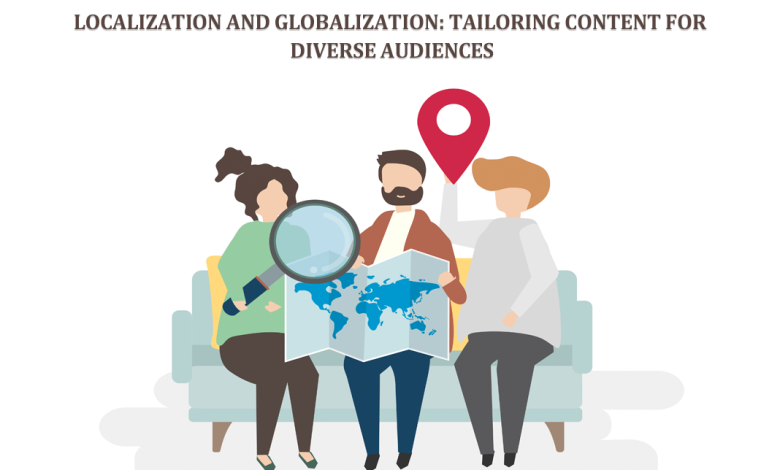
Businesses and content creators face a unique challenge in this dynamic landscape: effectively communicating with diverse audiences across different cultures and languages. A one-size-fits-all approach simply won’t cut it. Content must be tailored to their specific needs and preferences to truly resonate with international audiences.
This is where the concepts of localization and globalization come into play. Localization refers to adapting content to a specific locale, considering language, cultural references, and regional formatting. Globalization, on the other hand, focuses on creating a consistent brand identity and core message that can be understood across different markets.
Both are crucial for effective communication in today’s globalized world. Localization ensures cultural relevance and audience connection, and globalization provides a foundation for brand recognition and trust. By striking the right balance between these two strategies, businesses, and content creators can unlock the full potential of the global market.
The Power of Localization
Localization is the magic key that unlocks the door to successful communication in a globalized world. Businesses can reap many benefits by adapting content to resonate with specific audiences.
Benefits of Localization
- Increased market reach
- Enhanced brand awareness
- Better user experience
- Increased customer satisfaction
- Building trust
- Stronger customer relationships
- Increased sales
- Enhanced marketing ROI
- Better content value
Key Aspects of Localization
Localization isn’t simply translating words. It’s a multifaceted process that requires a deep understanding of the target culture. Here are some vital details to consider:
- Language Translation: A skilled translator can ensure accurate and natural-sounding language that considers cultural nuances and avoids literal translations that might sound awkward. Preserving the essence of idioms and wordplay further enhances the message’s impact.
- Cultural Adaptation: Humor, references, and symbols can be culturally specific. Localization ensures these elements are adapted appropriately to avoid causing offense or confusion. Replacing culturally insensitive references with local equivalents strengthens the connection with the audience.
- Regional Formatting: Formatting conventions like date and time formats, measurement units (metric vs. imperial), and currency symbols need to be adjusted to match regional standards. This ensures a smooth user experience and avoids confusion.
- Legal and Regulatory Compliance: Legal and regulatory requirements vary significantly between countries. Localized content must comply with local laws and regulations to avoid legal issues and ensure a smooth market entry.
- Content Personalization: Localization is not a one-size-fits-all solution. Consider tailoring content to address each target audience’s specific interests and needs. It can involve highlighting relevant local examples, case studies, or statistics to enhance engagement.
By mastering these essential aspects, you can transform your content into a powerful tool for connecting with diverse audiences across the globe.
The Challenges of Localization
While localization offers many benefits, it has its challenges. Successfully navigating the complexities of adapting content for diverse audiences requires careful planning and strategic execution. Here’s a breakdown of some key challenges and potential solutions:
Cost and Resource Management
Localization can be a resource-intensive endeavor. Translating content, adapting visuals, and complying with regional regulations require dedicated resources and financial investment.
The solution is prioritizing high-potential markets, utilizing translation management systems (TMS), using content localization tools, and collaborating with local agencies or freelancers with in-depth knowledge of the target market.
Maintaining Brand Voice and Messaging Consistency
Across adaptations, it’s crucial to maintain a consistent brand voice and core messaging while tailoring content to resonate with local audiences.
For this, you need to develop a comprehensive brand style guide, implement a centralized content management system (CMS), and educate your localization team on cultural nuances and potential pitfalls.
Ensuring Cultural Sensitivity
Humor, references, and symbols can have different meanings across cultures. Localization efforts must be culturally sensitive to avoid unintentional offense.
The solution to this issue lies in conducting thorough market research, working with translators and cultural consultants, and involving native speakers in the review process to ensure cultural appropriateness and avoid misinterpretations.
Also, you should adapt visuals, colors, and text to resonate with local preferences when designing your WooCommerce Banners. This approach ensures your banner complements your localized content.
Keeping Pace with Local Trends
Local trends and preferences can evolve rapidly. Localized content needs to remain current to maintain relevance and audience engagement.
To overcome this challenge, you should continuously monitor local trends and preferences, develop an agile content creation process, and collaborate with local marketing experts who can provide insights into emerging trends and cultural shifts.
Navigating Legal and Regulatory Differences
Legal and regulatory requirements vary significantly across regions. Localized content must comply with local laws and regulations to avoid legal issues.
For this, you need to get legal counsel with expertise in the target market, adapt disclaimers, terms of service, and privacy policies to comply with regional regulations, and research any industry-specific regulations that may apply to your localized content.
The Role of Globalization
Localization is essential for resonating with specific audiences. Still, it shouldn’t come at the expense of losing sight of your core brand identity. Globalization plays a crucial role in maintaining consistency and building brand recognition even while adapting content for diverse markets.
Maintaining a Core Brand Identity
Imagine a brand transforming its voice, visuals, and messaging with every localization effort. Consumers might struggle to recognize the brand or understand its core values. Localization should be about adapting the presentation, not the essence of your brand.
You can maintain a core brand identity while localizing by clearly defining your brand DNA, maintaining consistency in core brand elements, and ensuring that your core brand message remains consistent.
Building Brand Recognition Through Consistency
Globalization, through brand consistency, helps build strong brand recognition on a global scale. Here’s how:
- Creating a Unified Brand Experience: Maintaining consistent visual and messaging elements across different markets creates a unified brand experience for consumers worldwide.
- Increased Brand Memorability: Consumers are more likely to remember a brand with consistent elements encountered across various touchpoints, regardless of location.
- Building Brand Trust: Consistency fosters trust in consumers. They understand what your brand stands for, regardless of language or cultural adaptation.
Benefits of Standardized Elements
Standardized elements like logos, slogans, and core brand messaging offer a multitude of benefits, including:
- Streamlined brand management
- Scalability and efficiency
- Leveraging brand equity
By striking the right balance between localization and globalization, businesses can create a powerful brand experience that resonates with diverse audiences while maintaining a strong, consistent brand identity on the global stage.
Striking the Balance: Localization Meets Globalization
The dance between localization and globalization is a delicate one. While effective communication hinges on both strategies, achieving the right balance can be challenging. Let’s explore the pitfalls and strategies for navigating this dynamic landscape.
Challenges in Balancing Localization and Globalization
- Maintaining brand consistency
- Inauthentic communication
- Cost and resource management
- Managing complexity
Avoiding the Pitfalls
You can avoid these pitfalls by clearly defining your brand DNA, conducting thorough market research, prioritizing markets and efficiently using translation management systems (TMS), and implementing a centralized brand management system with clear guidelines for local adaptations.
By following these strategies, businesses can successfully balance localization and globalization. It ensures strong brand recognition while allowing communication to resonate with diverse audiences worldwide. This balanced approach unlocks the true potential of global communication, fostering deeper connections with international customers and propelling businesses to success in the global marketplace.
Conclusion
The interconnected world presents a vast and exciting landscape for businesses and content creators. You can unlock the potential to connect with diverse audiences globally by harnessing the combined power of localization and globalization.
The key lies in striking the right balance between these two forces. You can create a compelling global communication strategy by carefully tailoring your content while maintaining a solid brand identity. This approach will break down language barriers and build meaningful connections that fuel international success.
Embrace the challenge, navigate the complexities, and unlock the power of global communication. The world awaits your message!




